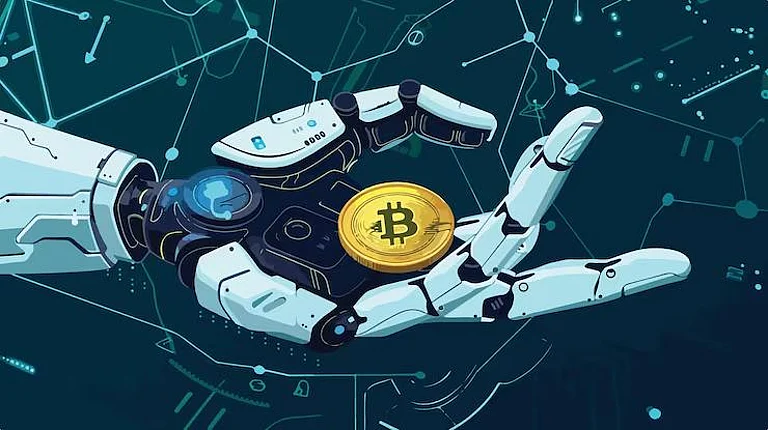Over the past few years, the convergence of artificial intelligence (AI) and blockchain technology has been one of the most promising spaces of innovation. While blockchain gives us a transparent and decentralized means of recording data, AI gives us sophisticated means of analyzing data and extracting valuable insights. These technologies combined are revolutionizing how data is stored, interpreted, and used in various industries.
One of the biggest challenges of blockchain is how to handle the huge amount of data that it produces. Every transaction in a blockchain gets recorded in a distributed ledger that is always expanding. With more and more users and applications implementing blockchain, the size of data keeps growing larger and larger. This is sometimes referred to as "blockchain big data." Interpretation of such data is a task, and the conventional method lacks when coping with its depth and volume. Here, AI steps in.
Interpretation of Blockchain Big Data

To get a hang of it before jumping to the role AI has to play, it needs to be noted why blockchain data stands out from other data types. Unlike other centralized databases, blockchain data is
Decentralized—None controls the dataset in its entirety.
Immutable—The data once stored cannot be edited.
Transparent—The data can be viewed and checked by anyone on the network.
Chronological—Transactions are stored in blocks, and these blocks are arranged sequentially.
All of these attributes make blockchain an invaluable resource to create trust and decrease fraud. Yet they are also part of the data complexity in analysis. For instance, with thousands of nodes that add up to a blockchain and millions of transactions taking place in real-time, identifying patterns or discovering anomalies is made difficult without specialized tools.
How AI Helps Analyze Blockchain Data

Artificial intelligence is able to analyze and process vast amounts of intricate data much more efficiently and accurately than traditional software or human beings. In blockchain, once applied, the AI algorithms can search through enormous datasets, learn from trends, and provide predictive analysis. Let's see how this works in detail.
1. Predictive Analytics and Pattern Recognition
One of the most significant uses of AI in blockchain is pattern identification. AI systems like machine learning can be trained to identify patterns in transactional histories. For example, AI can look at how frequently certain kinds of transactions occur or spot patterned behavior in cryptocurrency exchanges. This aids in trend forecasting, price prediction, or even detecting network spikes.
2. Fraud Detection and Risk Management
The transparency of blockchain makes it more difficult to fake records, yet it does not prevent all danger. AI may assist by watching the blockchain for anomalous or suspicious behavior. For instance, if a batch of tokens is suddenly transferred from one account to another within a brief period of time, AI systems can highlight this as being potentially dangerous. This is particularly beneficial in banking, where money laundering and fraud must be contained quickly.
3. Smart Contract Optimization
Smart contracts are automatically executing contracts whose terms are directly written in code. Smart contracts heavily depend on correct data to execute. AI can review previous smart contract executions, determine the most common points of failure, and recommend fixes. It can also help to automate decision-making within smart contracts, making them more adaptive and intelligent.
4. Network Health and Performance Monitoring
In blockchain networks, performance and security have to be kept high. AI tools assist in tracking the general health of the network through monitoring transaction speeds, block times, and user actions. When inefficiencies or abnormalities are noticed, developers can be alerted to rectify the same. Such an intervention helps keep the blockchain environment stable and secure.
5. Natural Language Processing for Blockchain Data
Most blockchain platforms produce data in different forms, such as text from news, forums, and white papers. Natural Language Processing (NLP) powered by Artificial Intelligence can dig through this data to provide meaningful insights. For instance, sentiment analysis via NLP can assist investors in interpreting market responses based on public sentiment or news coverage of a particular blockchain project.
Real-World Applications
Some industries are already investigating the possibilities of integrating AI and blockchain. In finance, AI is utilized to scan transaction history for fraud and market forecasts. In medicine, blockchain provides safe and tamper-proof storage of patient information, and AI assists in interpreting that information for improved diagnosis and treatment plans. Likewise, in supply chain management, blockchain offers traceability, and AI assists in optimizing logistics and inventory based on historical and real-time data.
In the crypto universe, AI-powered bots are employed to automate trading strategies by processing market trends derived from blockchain data. Such bots are able to make decisions within a split second that are hard for human traders to replicate.
Challenges and Considerations
Even with its promise, implementing AI and blockchain together also poses challenges. Perhaps the biggest challenge is data privacy. Even though blockchain is open, not all data must be open. In particular, in more sensitive areas such as healthcare, not all data must be available to the public. AI applications need to make sure that privacy is maintained while processing data. Second, maintaining the integrity of AI models demands clean, high-quality data, which may prove to be challenging to achieve from decentralized sources.
There are also computational issues. Processing AI models for blockchain data takes massive processing power, and how to do this in a decentralized system without relying on the centralized cloud infrastructure is an ongoing field of inquiry.
The Road Ahead
The future of AI and blockchain integration is promising. As technology develops, we will see more effective tools for managing and analyzing blockchain big data. Governments, startups, and multinational corporations are making greater investments in these technologies to enhance decision-making, cut costs, and boost transparency.
Eventually, AI will serve as the interpreter brain that makes sense of the enormous amount of blockchain data, enabling it to reach its full potential. As both technologies mature, their union will most likely become a standard component of digital infrastructure in industries.

















![[2026년 최신판] 토토사이트 순위 추천 기준과 선택 방법 안내 [2026년 최신판] 토토사이트 순위 추천 기준과 선택 방법 안내](https://media.assettype.com/outlookindia/2025-11-27/gto60xat/2026년-최신판-토토사이트-순위-추천-기준과-선택-방법-안내?w=200&auto=format%2Ccompress&fit=max)







